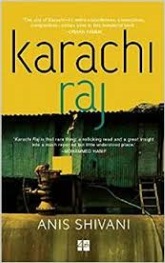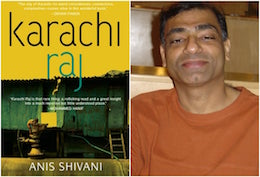Karachi Raj
Anis Shivani

Paperback: 412 pages
|
About half-way through Anis Shivani’s rambling, open, generous novel, Karachi Raj, a photographer named Tipu appears at the home of Claire, an American anthropologist working in the huge slum referred to as “the Basti”. During their conversation, he suggests that anthropologists like her think of people they observe as primitive. She protests, saying that the people from the Basti have a lot to teach. “Silence is unfortunately the default mode for poor people.” In a sense, Karachi Raj feels like an effort to break that default mode, to tell the truths and the important aspects of learning that can be found in the Basti. The book is an effort by its characters and its author to break the silence of those living in poverty and those on the margins of society. Part of this comes from the material itself. In a 2013 interview with Free Press Houston, Shivani said that the Basti was based on “an actual slum called Orangi Pilot Project, founded by a major South Asian NGO leader, Akhtar Hameed Khan, who started his efforts in what used to be East Pakistan, and then brought it to West Pakistan after 1971… Khan believed that slum dwellers could improve their lot by …taking the initiative to make their environment conducive to health and prosperity.” It is these slum dwellers that drive the narrative. There is the sister-brother duo, Seema and Hafiz, one attending university and infatuated with a professor and the other working as a labourer. There is the anthropologist, Claire, from Boston University, there is the professor himself, improbably named Ashiq; Hafiz’s old school friend, Majid, who has gone on to become fabulously rich and has married a starlet; and a host of secondary characters beautifully etched out, such as the Claire’s two colleagues at the NGO: Karim, who thinks she wants to convert to Islam; and Abdullah, an economist who has just returned after a fellowship at the London School of Economics. The driving force, though, lies in Hafiz and Seema’s urgency to change their lives. They exemplify the desire to “better themselves”. Seema is driven by a clearer idea, while Hafiz becomes a “parrot”, copying ideas from those around him, easily influenced, and completely at the mercy of others. Through their eyes, through Karachi University, life in a factory, a driver’s life, that of a starlet’s assistant, Shivani etches out Karachi, its promises — many of them false — and its unexpected beauty. Claire’s life, in some ways, is more compelling. Although she is the visitor, the NGO she works for is what keeps the Basti together. The Basti is bigger than either Seema or Hafiz, housing up to one million people. It moulders and changes slowly, if at all, and the shocking end seems to draw out exactly how little difference all the good intentions, effort andresearch thrown at the slums make in the tragedies of those who live there. Shivani wanted this to be a book about Karachi, and in this he fails, for good reasons. He is far too interested in his characters and their lives are too real. To cover the whole city, he would have had to write a far more superficial book. This one is deeply immersive, throwing up fascinating individuals, telling their small stories with great detail. Omair Ahmad | 27 June 2015 | The Indian Express
|

 Anis Shivani’s homage to Karachi
Anis Shivani’s homage to Karachi